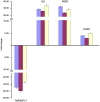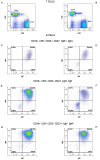Gene expression profiling in peripheral blood mononuclear cells of patients with common variable immunodeficiency: modulation of adaptive immune response following intravenous immunoglobulin therapy
- PMID: 24831519
- PMCID: PMC4022614
- DOI: 10.1371/journal.pone.0097571
Gene expression profiling in peripheral blood mononuclear cells of patients with common variable immunodeficiency: modulation of adaptive immune response following intravenous immunoglobulin therapy
Abstract
Background: Regular intravenous immunoglobulin treatment is used to replace antibody deficiency in primary immunodeficiency diseases; however the therapeutic effect seems to be related not only to antibody replacement but also to an active role in the modulation of the immune response. Common variable immunodeficiency is the most frequent primary immunodeficiency seen in clinical practice.
Methods: We have studied the effect of intravenous immunoglobulin replacement in patients with common variable immunodeficiency by evaluating the gene-expression profiles from Affimetrix HG-U133A. Some of the gene array results were validated by real time RT-PCR and by the measurement of circulating cytokines and chemokines by ELISA. Moreover we performed FACS analysis of blood mononuclear cells from the patients enrolled in the study.
Results: A series of genes involved in innate and acquired immune responses were markedly up- or down-modulated before therapy. Such genes included CD14, CD36, LEPR, IRF-5, RGS-1, CD38, TNFRSF25, IL-4, CXCR4, CCR3, IL-8. Most of these modulated genes showed an expression similar to that of normal controls after immunoglobulin replacement. Real time RT-PCR of selected genes and serum levels of IL-4, CXCR4 before and after therapy changed accordingly to gene array results. Interestingly, serum levels of IL-8 remained unchanged, as the corresponding gene, before and after treatment. FACS analysis showed a marked decrease of CD8+T cells and an increase of CD4+T cells following treatment. Moreover we observed a marked increase of CD23⁻CD27⁻IgM⁻IgG⁻ B cells (centrocytes).
Conclusions: Our results are in accordance with previous reports and provide further support to the hypothesis that the benefits of intravenous immunoglobulin therapy are not only related to antibody replacement but also to its ability to modulate the immune response in common variable immunodeficiency.
Conflict of interest statement
Figures




Similar articles
-
Intravenous immunoglobulin replacement therapy in the treatment of patients with common variable immunodeficiency disease: an open-label prospective study.Clin Drug Investig. 2011;31(5):299-307. doi: 10.1007/BF03256928. Clin Drug Investig. 2011. PMID: 21473654
-
Impaired CD8(+) T cell responses upon Toll-like receptor activation in common variable immunodeficiency.J Transl Med. 2016 May 17;14(1):138. doi: 10.1186/s12967-016-0900-2. J Transl Med. 2016. PMID: 27188997 Free PMC article.
-
Modulation of adaptive immune response following intravenous immunoglobulin therapy in common variable immunodeficiency.Isr Med Assoc J. 2014 Oct;16(10):648-50. Isr Med Assoc J. 2014. PMID: 25438459 No abstract available.
-
[Common variable immunodeficiency. Review].Allergol Immunopathol (Madr). 2001 May-Jun;29(3):113-8. doi: 10.1016/s0301-0546(01)79029-5. Allergol Immunopathol (Madr). 2001. PMID: 11434884 Review. Spanish.
-
[Primary immunodeficiency in adults: common variable immunodeficiency--clinical manifestations, immunological and genetic defects, treatment].Ter Arkh. 2011;83(10):49-54. Ter Arkh. 2011. PMID: 22185026 Review. Russian.
Cited by
-
Gene Expression Profiles in Primary Sjögren's Syndrome With and Without Systemic Manifestations.ACR Open Rheumatol. 2019 Oct 21;1(10):603-613. doi: 10.1002/acr2.11082. eCollection 2019 Dec. ACR Open Rheumatol. 2019. PMID: 31872181 Free PMC article.
-
Persistent Immune Activation in CVID and the Role of IVIg in Its Suppression.Front Immunol. 2014 Dec 16;5:637. doi: 10.3389/fimmu.2014.00637. eCollection 2014. Front Immunol. 2014. PMID: 25566250 Free PMC article. Review.
-
Immune Response to Rotavirus and Gluten Sensitivity.J Immunol Res. 2018 Mar 15;2018:9419204. doi: 10.1155/2018/9419204. eCollection 2018. J Immunol Res. 2018. PMID: 29736406 Free PMC article.
-
Chemokine receptor-4 targeted PET/CT with 68Ga-Pentixafor in assessment of newly diagnosed multiple myeloma: comparison to 18F-FDG PET/CT.Eur J Nucl Med Mol Imaging. 2020 Mar;47(3):537-546. doi: 10.1007/s00259-019-04605-z. Epub 2019 Nov 27. Eur J Nucl Med Mol Imaging. 2020. PMID: 31776631 Clinical Trial.
-
Characteristics of the patients followed with the diagnosis of common variable immunodeficiency and the complications.Cent Eur J Immunol. 2019;44(2):119-126. doi: 10.5114/ceji.2019.87060. Epub 2019 Jul 30. Cent Eur J Immunol. 2019. PMID: 31530980 Free PMC article.
References
-
- Sokos DR, Berger M, Lazarus HM (2002) Intravenous immunoglobulin: appropriate indications and uses in hematopoietic stem cell transplantation. Biol Blood Marrow Transplant 8: 117–130. - PubMed
-
- Bayry J, Lacroix-Desmazes S, Delignat S, Mouthon L, Weill B, et al. (2003) Intravenous immunoglobulin abrogates dendritic cell differentiation induced by interferon-alpha present in serum from patients with systemic lupus erythematosus. Arthritis Rheum 48: 3497–3502. - PubMed
-
- Notarangelo LD (2010) Primary immunodeficiencies. J Allergy Clin Immunol 125: S182–194. - PubMed
-
- Salzer U, Unger S, Warnatz K (2012) Common variable immunodeficiency (CVID): exploring the multiple dimensions of a heterogeneous disease. Ann N Y Acad Sci 1250: 41–49. - PubMed
Publication types
MeSH terms
Substances
LinkOut - more resources
Full Text Sources
Other Literature Sources
Molecular Biology Databases
Research Materials
Miscellaneous

